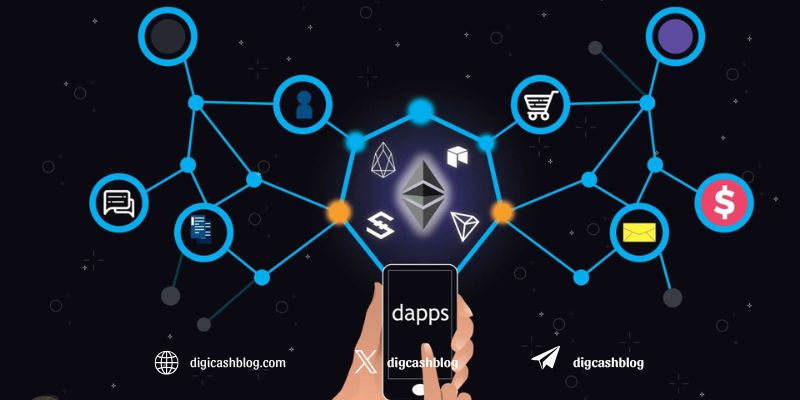Introduction to Decentralized Applications in 2025
Decentralized applications (dApps) are reshaping the cryptocurrency ecosystem by leveraging blockchain technology to offer transparent, secure, and intermediary-free solutions. Built on smart contract platforms like Ethereum, Solana, and newer Layer 1 blockchains, dApps span DeFi, gaming, NFTs, and more, driving innovation in the $2.66 trillion crypto market in 2025. The cryptocurrency trends in decentralized applications (dApps) for 2025 highlight advancements in scalability, AI integration, and real-world utility, fueled by institutional adoption and regulatory clarity. This article explores these trends, their impact on the crypto market, and how traders can leverage technical analysis to capitalize on dApp-related opportunities.
Growth of DeFi-Driven dApps
Decentralized Finance (DeFi) remains a cornerstone of dApp development, with platforms like Uniswap, Aave, and Lido dominating the space. In 2025, DeFi dApps are projected to surpass $200 billion in total value locked (TVL), driven by sophisticated protocols offering lending, borrowing, and trading without intermediaries.

Key Developments: Enhanced user interfaces and lower transaction fees via Layer 2 solutions (e.g., Optimistic Rollups, Arbitrum) make DeFi dApps more accessible. For instance, Ethereum’s Layer 2 scaling solutions reduce costs, boosting adoption for dApps like Curve.
Market Impact: DeFi tokens (e.g., UNI, AAVE) are rebounding, with posts on X noting increased staking activity and institutional interest.
Technical Analysis: Traders can use on-chain analysis to monitor TVL growth and transaction volumes on DeFi dApps. A spike in Uniswap’s on-chain volume, combined with a bullish Moving Average (MA) crossover (e.g., 50-day SMA above 200-day SMA), signals potential price appreciation for UNI.
AI-Powered dApps and Decentralized AI Networks
The integration of artificial intelligence (AI) with dApps is a transformative trend in 2025, creating decentralized AI networks that enhance automation and decision-making. Projects like Bittensor and Fetch.ai enable developers to build, share, and monetize AI tools on blockchain, bypassing centralized tech giants.
Key Developments: Bittensor’s subnet model fosters collaboration on AI tasks, while projects like Ambient (backed by a16z) integrate AI directly into blockchain operations, enhancing dApp efficiency.
Market Impact: AI tokens have surpassed $39 billion in market value, with X posts highlighting user demand for AI-driven trading tools and privacy-centric wallets.
Technical Analysis: Traders can combine volume analysis with AI token price charts. For example, a high-volume breakout in Fetch.ai’s FET token above a key resistance level, validated by increased on-chain activity (e.g., active addresses), suggests bullish momentum.
Real-World Asset (RWA) Tokenization via dApps
RWA tokenization is revolutionizing dApps by bringing assets like real estate, commodities, and art onto blockchains. In Q1 2025, the RWA market reached $20 billion, with projections to hit $50 billion by year-end.
Key Developments: dApps like Morpher enable trading of tokenized stocks and luxury goods, democratizing access to previously illiquid markets.
Market Impact: Tokenized securities on public blockchains, such as those on Provenance ($12 billion in tokenized private credit), are gaining traction, driving demand for dApp-native tokens.
Technical Analysis: Use Fibonacci retracement to identify support levels for RWA-related tokens. For instance, if a dApp token retraces to the 61.8% Fibonacci level with rising on-chain transaction volume, it may indicate a buying opportunity.
Interoperability and Cross-Chain dApps
Cross-chain interoperability is a critical trend, addressing fragmentation across blockchains. dApps on platforms like Polkadot and Cosmos facilitate seamless asset transfers and data sharing, enhancing liquidity and efficiency.
Projects like Wormhole, which raised $225 million, enable cross-chain connectivity, powering dApps that operate across Ethereum, Solana, and Binance Smart Chain.
Interoperability tokens like Cosmos (ATOM) and Chainlink (LINK) are seeing increased adoption, as noted in X posts discussing Polkadot’s role in dApp ecosystems.
Monitor MACD crossovers for interoperability tokens. A bullish MACD crossover for LINK, combined with high on-chain volume, can signal a trend continuation.

Decentralized Physical Infrastructure Networks (DePIN)
Decentralized Physical Infrastructure Networks (DePIN) are emerging as a dApp trend, enabling decentralized management of real-world infrastructure like energy grids or telecom networks.
DePIN dApps incentivize users to contribute resources (e.g., computing power, storage) via token rewards, fostering sustainable ecosystems.
DePIN tokens are gaining investor interest, with the MVIALE Index of dApp tokens expected to close the performance gap with Layer 1 tokens in 2025.
Use Bollinger Bands to identify breakout opportunities in DePIN tokens. A price move above the upper Bollinger Band with high volume suggests strong bullish potential.
Regulatory Clarity and Governance in dApps
Regulatory developments are shaping dApp ecosystems in 2025. The U.S.’s pro-crypto policies, including the repeal of the IRS’s DeFi broker rule, have created a favorable environment for dApp growth.
On-chain governance systems and smart contract-based arbitration are gaining traction, offering transparent dispute resolution for dApps.
Regulatory clarity boosts institutional participation in DeFi and RWA dApps, as seen with VanEck’s Sui blockchain ETN launch in Europe.
Traders can use RSI to assess overbought/oversold conditions in governance tokens (e.g., AAVE). An RSI below 30 near a key support level may indicate a buying opportunity.
Challenges Facing dApps in 2025
Despite their potential, dApps face challenges:
- High transaction costs on Ethereum persist, though Layer 2 solutions mitigate this.
- Smart contract vulnerabilities remain a risk, with $3 billion lost to hacks in 2022. Enhanced security protocols are critical.
- Fragmented global regulations, as noted in X posts, may hinder dApp adoption in some regions.
The cryptocurrency trends in decentralized applications (dApps) for 2025 highlight a maturing ecosystem driven by DeFi, AI integration, RWA tokenization, interoperability, and DePIN. With $200 billion in DeFi TVL and $50 billion in tokenized assets projected, dApps are central to the crypto market’s growth.
By combining on-chain analysis with technical tools like Moving Averages, RSI, and volume analysis, traders can capitalize on these trends. However, challenges like scalability and regulatory uncertainty require vigilance. Staying informed through platforms like X and leveraging robust strategies will enable investors to navigate the dynamic dApp landscape in 2025.
